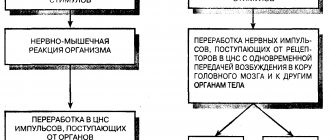In almost any area of life, a person from time to time is faced with the fact that certain obstacles and problems arise on his way. But it is not always possible to determine the true cause of the appearance of a particular problem, and it itself can only be a visible consequence of something that is hidden from our attention somewhere inside ourselves or the activity in which we are engaged. And in order to understand the main causes of problems and eliminate them, it is very convenient to resort to the use of a technique developed specifically for this purpose - the diagram of Kaoru Ishikawa, a professor at the University of Tokyo and a leading specialist in quality management. This diagram is also known as Root Cause Analysis Diagram, Cause and Effect Diagram, and Fishbone Diagram. The presented lesson is dedicated to describing this method as a useful tool in any work and everyday life.
Compilation method
The main goal is to have three to six main factors that cover all possible influences.
Based on the results of constructing the Ishikawa/Ishikawa diagram, the depth of such a tree reaches four or five levels. The depth of the levels allows you to visually assess the picture of all possible root causes of a particular problem. If there is difficulty in the main branches, then standard headings can be used: Personnel (people)
include factors determined by the condition and capabilities of a person. For example, this is a person’s qualifications, his physical condition, experience, etc.
Working Method (Technology)
includes the manner in which work is performed, as well as everything related to the productivity and accuracy of the performed operations of the process or activity.
Mechanisms
– these are all factors that are determined by the equipment, machines, devices used in performing actions. For example, the condition of the tool, the condition of the devices, etc.
Materials
- these are all the factors that determine the properties of the material in the process of performing work. For example, the thermal conductivity of the material, viscosity or hardness of the material.
Control
– these are all factors influencing the reliable recognition of errors in the execution of actions.
External environment (environment)–
These are all factors that determine the influence of the external environment on the performance of actions. For example, temperature, light, humidity, etc.
Consideration of the problem “Scatter in details”
Let's look at Ishikawa diagrams using an example of an enterprise.
An industrial enterprise engaged in the production of any parts is often faced with the problem of variation in part sizes.
To solve this problem, it is necessary to gather technologists, workers, suppliers, managers, engineers, and you can invite other people who will help find approaches that are not provided for by specialists in their field.
With a well-conducted analysis, it is not enough to identify only the factors causing the problem; they must be correctly ranked. This can be done during brainstorming, after the process of identifying causes has been completed. Each group member must evaluate the significance of individual reasons from his own point of view, after which the overall significance of the reasons will be determined.
In the presented Ishikawa diagram, using the example of an enterprise, the following first-order reasons were identified: workers, materials, technology, machine, measurements, environment and management.
The figure shows second and third order causes. Asking "Why?" So what?" you can get to the root cause that created the problem.
The group members determined that the most significant indicators affecting the scatter of parts are the measurement period and the accuracy of the instruments.
Thus, the significance does not depend on which order the cause belongs to.
How to make an ishikawa chart in Excel
Now let's leave the theoretical field and move on to the practical part. If you want to make Ishkawa Chart Sheet in Excel, you will need to follow some important steps to have good efficiency in using it:
Step 1 - Define the problem your business wants to solve
It is important that you use only one problem at a time on the Ishikawa diagram. Also, when writing the problem on the worksheet, do not use vague words or large sentences, be objective and punctual:. ishikawa diagram - low blog participation problem
ishikawa diagram - low blog participation problem
Step 2 - List the reasons that may be causing this problem.
Here you will need to list all the reasons that could be causing this problem.
Ishikawa Diagram - Reasons for a Little Blog Contribution
The important point is to differentiate the notes for each of these reasons in order to find out which ones are the most important and which affect the problem in a more direct way
Step 3 - Make a Fishbone Diagram
If you have researched the reasons well, you may have a great view of your fish belt diagram:
Ishikawa diagram - fish diagram visualization
This view is a simple way to analyze which elements are relevant and which are not.
Step 4 - Create Actions to Address the Most Important Causes
Now the process is very simple, you need to create action plans to eliminate or improve the way the emerging causes occur. To do this, the first step is to create these activities and register the responsible team to carry out this activity.
Ishikawa diagram - action plans to reduce the causes of the problem
In this way, you can create and monitor problems, their causes and actions needed to better manage your business with the help of ishikawa Excel chart.
Theoretical part
A cause and effect diagram is used, as a rule, when analyzing defects that lead to the greatest losses.
It allows you to identify the causes of such defects and focus on eliminating these causes. In this case, four main causal factors are analyzed: man, machine (equipment), material and method of work.
When analyzing factors, secondary and perhaps tertiary causes are identified that lead to defects and must be eliminated. Therefore, to analyze defects and construct a diagram, it is necessary to determine the maximum number of reasons that may be related to the defects.
It consists of a quality indicator characterizing the result and factor indicators (Fig. 1).
Fig.1. Cause-Result Diagram Structure
Such a diagram in the form of a “fish skeleton” was proposed by the Japanese scientist K. Ishikawa. It is also called the “branching diagram of characteristic factors”, and sometimes the “four M” diagram - based on the composition of the four main factors: Man, Method, Material, Machine. The diagram reveals the relationship between indicators and the factors affecting them. First, a problem or quality defect is formulated. This is the "fish head". The four main factors of analysis are the “large bones of the skeleton.” For each factor, probable causes of defects are plotted on the diagram - these are “edges”, i.e. “medium” and “small bones of the fish skeleton” (Fig. 2).
Fig.2. Ishikawa diagram.
Constructing diagrams includes the following steps:
Stage 1.
The quality indicator is determined, i.e. the result that needs to be achieved.
Stage 2.
The selected quality indicator is placed in the middle of the right edge of a blank sheet of paper. A straight line (“ridge”) is drawn from left to right, and the indicator is enclosed in a rectangle. Below are the main reasons that affect the quality indicator. They are enclosed in rectangles and connected to the “ridge” by arrows in the form of “big bones of the spine” (the main reasons).
Stage 3.
Write down (secondary) causes that influence the main causes (“big bones”). They are located in the form of “middle bones” adjacent to the “big bones”. Tertiary causes that influence secondary causes are recorded. They are arranged in the form of “small bones” adjacent to the “medium ones”.
Stage 4.
Reasons (factors) are ranked by their importance using a Pareto chart. Particularly important reasons are identified that presumably have the greatest impact on the quality indicator.
Stage 5.
All the necessary information is included on the diagram: title; name of the product, process or group of processes; names of participants in the process; date, etc.
The principle of constructing the diagram is shown in Fig. 3.
Rice. 3. The principle of constructing an Ishikawa diagram.
When structuring a diagram at the level of primary arrows of factors in many real situations, you can use the “five M” rule proposed by Ishikawa himself. It consists in the fact that in general there are the following five possible reasons for certain results: materials, machines, technology (methods), measurements, people. All these words in English begin with the letter “M”: Material, Machine, Method, Measurement, Man, which is where the name of this rule comes from. In Fig. Figure 4 shows the result of a group of 5 people determining the relative importance of the factors causing a loudspeaker speaker to fail to meet the quality standard.
Rice. 4. Ishikawa scheme with estimates of the significance of factors.
The diagram shows the most significant factors in accordance with the number of concentric rings on the factor arrows. They are: the consistency of the glue (4 rings), the deformation of the damper (3 rings) and the carelessness of the assemblers (3 rings).
In Fig. Table 5 shows, as an example, the most important possible reasons that influence the result of consumer dissatisfaction (consequences).
Fig.5. Cause-and-effect diagram to identify causes of customer dissatisfaction.
As examples in Fig. 6 and 7 show Ishikawa diagrams for monitoring product quality and the quality of specialist training.
Rice. 6. Factors affecting product quality.
The system of factors for quality education at a university can be represented using the Ishikawa diagram (Fig. 7).
Fig.7. Factors that most influence the quality of specialist training
Analysis of the causes of product defects
Let's look at the Ishikawa diagram using the example of analyzing the causes of product defects.
In this case, the consequence (problem) is a manufacturing defect.
During brainstorming, various reasons affecting product defects were identified. As a result of reaching a consensus by the participants in the brainstorming session, all the reasons were ranked, the unimportant ones were discarded and the most important factors were retained.
The first-order reasons included materials, equipment, components, labor, working conditions and technology.
They are directly influenced by second-order reasons: impurities, humidity, delivery, accuracy, control, storage, air environment, workplace, production culture, machine age, maintenance, discipline, qualifications, experience, tools, measuring instruments, technological discipline, documentation , equipment (its availability).
Second-order reasons are influenced by third-order reasons, which include temperature, storage humidity, inspection acceptance, lighting and noise at the workplace, and quality of equipment.
All these reasons are placed in appropriate places and an Ishikawa diagram is constructed. An example is shown in the figure. At the same time, you need to understand that other reasons may be identified by another group.
Description of the method
An Ishikawa diagram is a graphical way of exploring and identifying the most significant cause-and-effect relationships between factors and consequences in the situation or problem being studied. The diagram is named after one of the leading Japanese management theorists, Professor Kaoru Ishikawa (石川馨, romaji Kaoru Ishikawa
), who proposed it in 1952 (according to other sources - in 1943) as an addition to existing methods of logical analysis and improving the quality of processes in Japanese industry.
Ishikawa is one of the developers of a new concept of production organization, embodied in. The scheme proposed by Professor Ishikawa clearly shows the work to improve the quality of production processes. It, like most quality tools, is a means of visualizing and organizing knowledge that systematically facilitates the understanding and eventual diagnosis of a particular problem.
Such a diagram allows you to identify key relationships between various factors and more accurately understand the process under study. The diagram helps to identify the main factors that have the most significant impact on the development of the problem under consideration, as well as to prevent or eliminate the effects of these factors.
The scheme is widely used in the development of new products in order to identify potential factors whose action causes an overall effect.
An example of a cause-and-effect diagram showing 2 levels of bones.
The appearance of the diagram when viewing the field of the problem under study really resembles the skeleton of a fish (the eyes usually move from left to right, as when reading a line of text). The problem is indicated by a main arrow. Factors that aggravate the problem are shown with arrows tilted to the main right, and those that neutralize the problem are shown with arrows tilted to the left. As the level of analysis deepens, arrows of factors influencing them can be added to the arrows of second-order factors, etc. The figure shows such an example with two levels of bones: the 1st level is indicated in red - the main (radical): a, b, c ,d
, and blue 2nd level - in-depth (detailed) causes (factors)
of the studied influence on the result
(among the factors of the 2nd level are those that enhance the effect of the 1st level -
e, f, g, h, i, l, m, o, p
, and those that weaken it -
k, n
). Next, the separation of the detected factors is deepened according to their increasing specificity until the branches of the problem are subject to an additional section (in this case, it is necessary to identify the true causes, not the symptoms).
The key is to have three to six main categories that cover all possible influences. In fact, the maximum depth of such a tree reaches four or five levels. When such a diagram is created, it provides a fairly complete picture of all possible root causes for a particular problem.
The Ishikawa diagram is used as an analytical tool for viewing the action of possible factors and highlighting the most important causes, the action of which gives rise to specific consequences and can be controlled (see the materials of the seminar “Issues of standardization, accreditation and quality”).
Working with the Ishikawa diagram is carried out in several stages:
- Identification and collection of all factors and causes that in any way influence the result under study
. - Grouping of factors into semantic and cause-and-effect blocks
. - Ranking of these factors within each block
. - Analysis of the resulting picture
. - " Releasing
"
factors that we cannot influence
. - Ignoring minor and unimportant factors
.
To more effectively identify and add possible causes to the main ones, as well as to more specifically detail the possible root causes of the branches of the “main bone,” a method of stimulating the generation of creative ideas known as “brainstorming” is traditionally used. A typical application of this method is for a team leader to draw a diagram on a whiteboard, who first identifies the main problems and asks for help from a group of employees to identify the root causes, which are schematically indicated on the main bone of the diagram, and detail them. The group provides suggestions until eventually the entire cause-and-effect diagram is completed. Once the discussion is complete, it is decided what the most likely root cause of the problem is.
Features and Features
The Ishikawa diagram is also called the fishbone method and root cause analysis. It is presented in the form of a diagram, thanks to which it becomes possible to study and identify factors of the negative consequences of some activity or process, as well as to anticipate and prevent their occurrence in the future. Most often it is used to develop new products, ideas or technologies, as well as to clarify difficulties in providing services, manufacturing products, equipment breakdowns, etc.
Main advantages:
- Makes it possible to concentrate on the very content of the complexity that has arisen;
- Thanks to it, a discussion can arise in the team, during which weaknesses, pitfalls and other difficulties of the entire working system are identified. Due to overcoming obstacles, there is a high probability of obtaining a creative and effective solution to the problem;
- Easy to understand and applicable in any situation;
- An effect of collective knowledge is created when all employees at different levels are included in the process and, depending on their position and competence, can make changes. Let’s say that the manager may not have much information about the exact composition of the material of the manufactured products, so they will focus more on the opinion of employees who are directly responsible for the storage conditions and quality of the goods, the purchase of raw materials, etc.;
- The causes of troubles are formed into separate categories, which is very convenient for discussion. The people responsible for them can take turns participating in the process, giving others the opportunity to rest.
The first step is to agree on the problem statement or goal itself with all participants in the root cause analysis. Otherwise, disagreements that arise during the process will make it impossible to obtain the desired result.
Decor
- Choose a material that is convenient for you on which to draw the “fish skeleton”; it can be a regular sheet of paper, a board, etc.
- To improve the efficiency of perception, indicate the problem itself on the right side of the sheet, and draw a horizontal line to the left, from which you will draw diagonal small arrows that are responsible for the main problems that prevent you from achieving positive results. In this case, you really will have a “fish backbone”. Most often they are divided into groups to structure and simplify information processing.
Sample
I'll give you an example, a pattern that occurs most often. Let's take as a basis the complexity, which lies in the fact that the enterprise produced products, or more precisely, several batches that turned out to be defective, defective. So, the categories for the scheme are:
- “People” - here the reasons for the human factor are indicated, for example, the emergence of a new inexperienced employee, the illness of a team member who subsequently made a mistake, low motivation, which results in a negligent attitude towards one’s duties, possible internal conflicts or difficult relationships with the manager, if they decided to take revenge on him in this way by disrupting the project.
- “Methods” - perhaps it’s time to make changes, since old methods or technologies no longer work, or fail, which is reflected in the quality of the product.
- “Mechanisms” - here it’s all about the equipment itself, with the help of which the products are produced. It is necessary to carry out an inspection, possibly repair the breakdown or replace parts that have worn out. And sometimes the introduction of more modern equipment entails consequences such as low-quality, defective products.
- “Material” - in this cell you should indicate the characteristics of the material used in production. For example, composition, temperature, durability, etc. Perhaps the batch of material differs slightly in properties from those usually used, which led to defects.
- “Control” - takes into account the measures taken to prevent defective goods.
- “Environment” - for example, changes in weather conditions could affect the production process. Let’s say there is poor visibility, high or low temperature in the workshop...
Filling
- Now it is necessary to indicate the secondary factors that are related to the main ones, and they should be displayed in the figure in the form of “middle bones”. Then they seem to be adjacent to the main diagonal ones.
- Next, we draw even smaller “bone arrows” that are adjacent to the middle ones. These will be tertiary difficulties that affect the secondary ones. If they are not there, you still draw arrows; they may “pop up” in the future, so you need free space in reserve.
- Indicate even the smallest and insignificant nuances; at the end of the analysis, it may turn out that they actually play a major role. And a little advice: highlight in color those factors that, in your opinion, negatively and positively affect the result. For example, red color represents threatening or destructive moments, green color helps to develop. Then it will be easier for you to navigate all the schemes, blocks and branches.
Analysis
- All factors must be assessed and ranked according to the significance of their impact on the problem.
- It should be taken into account that until the analysis of the diagram is completed, you should not proceed to specific actions, this may interfere with the expected results.
- Try to ask yourself the question: “Why?” every time you introduce factors that negatively affect the efficiency of your process. Such reflection will help generate ideas and understand the sequence of events.
- You should not ignore data such as names, time, exact location and other points directly related to the problem you want to solve.
Rules
1) determine the goal;
2) all team members participate in the discussion;
3) it is recommended to exclude fruitless conversations, valuing ideas and conscious handling of facts;
4) there must be teamwork in the development of any thoughts expressed to team members;
5) participants should not feel afraid to express their ideas;
6) criticism is not allowed, all ideas are written down, not a single idea is immediately rejected;
7) proposals are not limited only to factors related to the speaker’s activities;
 team members should be encouraged to unleash their creative potential;
team members should be encouraged to unleash their creative potential;
9) management personnel are not recommended to speak out first;
Rule of five M's
Despite the apparent simplicity of construction, Ishikawa’s “fish bone” requires a thorough knowledge of the object of analysis from the performers, a clear understanding of the mutual dependence and influence of factors on each other.
To facilitate the construction of such a scheme, you can use the five “M” rule, which was proposed by its author. It lies in the fact that when analyzing many real situations, the primary (root) causes are the following:
- Man (people) - reasons that are associated with the human factor.
- Machines (machines or equipment).
- Materials - reasons related to resources or materials.
- Methods (methods, technologies) - reasons associated with the organization of processes.
- Measurements (measurements or finances).
This is why the Ishikawa diagram is sometimes called the “5M analysis diagram.”
General information
Ishikawa Fishbone Diagram is one of the graphical methods or methods that are applicable in determining the most significant (root) cause-and-effect relationships when studying a situation or problem.
This is a method of visualizing a problem: a graphical representation of the connection between the inconsistency (problem) and the reasons that influence it.
This graphic diagram is named after one of the most famous management theorists - Japanese professor Kaoru Ishikawa. He developed this method and introduced it into circulation in the mid-19th century. Graphically, the diagram looks like a fish skeleton, which is why it is called a fishbone.
Ishikawa diagram example in an enterprise or production
An example of an Ishikawa diagram in production. For example, the defect rate in the workshop has increased by 13% over the past month.
Let's draw a diagram.
For this example, let's take 4 main positions:
- People;
- Method;
- Tools;
- Car.
Here I will not describe every detail, but for general understanding - the problems heard during brainstorming.
People - machines work around the clock, a shift worker suddenly fell ill, and the second one is on vacation. They hired an inexperienced “green” worker. The person did not work on this machine. There is an atmosphere of mistrust in the shop between shifts; each shift locks its tools under lock and key. There is no agreement between shifts.
Machine - gap 0.2 millimeters tolerance. Allows parts to dangle. An experienced worker knows this part of the conveyor and automatically places the part “as it should.” Marriage varies within normal limits. The new employee didn't know this. There is no regular inspection of machines.
Material – during the communication, a flaw in the warehouse workers was discovered that did not in any way affect this issue. But that could come back to haunt us with more serious problems in the future. We placed an order for a large batch of blanks from a new supplier. And from the very beginning they are no longer suitable in quality for production tasks.
Method – at this production there are no clear work standards and a bonus system that is incomprehensible to employees.
Solutions:
- Train a young specialist;
- The second is to protect against the “fool” - adjust the gap to a minimum, invite an adjuster;
- Apply the 5 S system (you can read more here)
- Set up equipment;
- Create a schedule for checking machines;
- Carry out debugging for preventive purposes throughout the workshop;
- Make trial batches from new suppliers;
- Change the supplier urgently and try to negotiate a return;
- Prepare work standards on your own or invite a consultant;
- Communicate KPI principles to all employees.
As you understand, this list of solutions is not limited to, and there will be more branches on the cause-and-effect diagram.
In some cases, it is necessary to supplement the branches of the fish skeleton with even more bones. For example, as was the case when optimizing processes in a bank.
Rules for constructing an Ishikawa diagram
In order for the work to be productive and really help in solving problematic issues, you should follow some recommendations when constructing a diagram.
- Each employee participating in the construction of the diagram must have a clear understanding of the problem that requires a solution. To do this, the problematic issue must be chosen unanimously. Sometimes management already knows the direction in which to think, in which case the manager reports the problematic situation.
- For convenience and clarity, each heading should be framed. This way, the boundaries will be clearly demarcated, which will eliminate possible confusion and misunderstanding.
- Even the most insignificant fact should be noted in the diagram, sometimes the little things are underestimated, but they are crucial.
- It is advisable to indicate under the diagram or to the side each person who participated in its creation; in addition, the date of compilation, the name of the enterprise and other notes are indicated, at the request of the manager.
- The main problem, i.e. the main block, should be placed on the right side of the sheet, and the “ridge” and blocks with reasons should be placed on the left side.
- After identifying one or another problematic fact, it is necessary to ask the question: “Why?” in order to determine why this factor arose and whether there are ways to eliminate it.
- The wording should be brief, but fully revealing the essence of the phenomenon. Try to avoid complex syntactic structures, they will greatly complicate perception. In addition, they are bulky, the diagram will look blurry and sloppy.
The main principles of working with the circuit
When compiling and analyzing an Ishikawa diagram, it is important to adhere to the following rules:
- It is necessary to take into account everything, even the most insignificant factors and problems. Only in this way does it become possible to find the root cause of the situation, and therefore to find the most effective solution to it.
- During the analysis, it is important to evaluate factors according to their significance. Thus, the root factors are identified - those that influence the situation the most.
- By entering the most complete information into the diagram (names of reasons, dates, names of participants, names of products), the situation or problem becomes clear and visual.
- Important! The process of search and analysis, interpretation of problems and factors is a fundamental part in creating a holistic picture and those specific actions or directions of movement that can solve a problem or resolve a situation.
Apply layout to make the diagram clear and readable
Use fonts to make your diagram easy to read. Canva's tool gives you access to thousands of free, coordinating fonts. Try using a bold font such as Raleway to highlight the main problem, and print the reasons and details of the problem in a less bold font such as Open Sans Light.
Additionally, you can change the text color, background, and element design to suit your brand. If you're a Canva Pro subscriber, you can add your own fonts and apply them to any design for a professional look.
Graphic rules
When drawing a fishbone diagram, large first-order arrows are attached to the main horizontal arrow, which depicts our object of analysis, which indicate root factors or groups of factors that influence the object. Arrows of the first order are connected to arrows of the second, to them - of the third, and so on until all the factors influencing the object or situation are taken into account.
Moreover, each subsequent arrow in relation to the arrow of the previous order is a cause, and each subsequent one is a consequence.
The size of the picture and its shape are absolutely not important. The main thing is to correctly distribute the subordination and mutual dependence of factors.
Moreover, the clearer the fishbone is, the better the diagram looks and reads.
Classification of causes that form the “skeleton” of the diagram
The Ishikawa diagram consists of a central vertical arrow, which actually represents the effect, and large “edges” approaching it, which are called first-order causes. Smaller arrows, called second-order causes, approach these “edges,” and even smaller arrows approach them, called third-order causes. Such “branching” can take a very long time, up to reasons of the nth order.
Preface
In 1953, Tokyo University professor Kaoru Ishikawa, discussing a quality problem in a factory, summarized the engineers' opinions in the form of a cause-and-effect diagram. Over time, the diagram began to be used in practice, and it turned out to be very useful and eventually became widespread in many companies in Japan. Subsequently included in the Japanese Industrial Standard (JIS) for quality control terminology, it is defined as follows: cause-effect diagram - a diagram that shows the relationship between a quality indicator and the factors affecting it. The diagram was named after Kaoru Ishikawa, who made invaluable contributions to the development of industry and economics in Japan. There are two transcriptions of the professor's surname: Ishikawa and Ishikawa
. Ishikawa in Russian pronunciation is Ishikawa. (L.G. Golubkova presentation “Management schemes in the organization”)
How to construct an Ishikawa diagram and where
The need to fill out the Ishikawa diagram arises when a problem arises or the business has reached a dead end. This is a universal tool that allows you to quickly find solutions or at least ideas for solutions.
The subtleties of the principle of working with a diagram are a little broader than just construction.
Stages of work:
- Problem;
- Working group;
- Review each area;
- Use brainstorming;
- Work only with what you can influence;
- Use a prioritization matrix if there are a lot of ideas;
- Make an action plan with deadlines and responsibilities.
And about each stage in more detail.
First stage
Usually, before drawing up a diagram, you need to formulate the question correctly.
This point - drawing up the right question - needs to be given special attention. Because it may turn out that the more vague the question, the more inaccurate the information will be at the output
The question or problem is voiced specifically and accurately using SMART. With the definition of deadlines and digitization of the depth of the problem.
In example 1 question, the problem is this: in the b2b sector, sales have fallen by 38% over the last 3 months. So we voice the question. Why did sales fall by 38% in 3 months in the sales department?
Be sure to mark the formulated question on the diagram, in the “head of the fish.” This will allow you to stay on top of the problem all the time.
Second phase
Next, a working group of at least 3 people is assembled. It is highly desirable that a line manager be present in the work group. The powers of which can allow you to solve the problem faster and better. It would also be good to invite 1-2 people who are not participants in the business process for research. Outside people with an unbiased view. This will allow new, unexpected questions and solutions to emerge.
Although if conditions do not allow, you can create a diagram yourself. Simply having a team makes the effort much more effective. On paper, outside of any programs, we draw for ourselves, not for presentations.
Third stage
Basic criteria for information processing (First Order Base):
- Man people,
- material,
- Machine equipment,
- method,
- management management,
- Measurement
Technically, the Fishbone consists of one main axis. It is adjoined by “bones” of the first order, followed by reasons of the second order, and so on until the conclusion of the reasoning. By the way, sometimes you can find information in the literature or on the Internet about the 6 M or 4 M method. These are the main blocks of the Ishikawa diagram.
You can take only 4 main criteria to determine the root causes. Nobody bothers you to add blocks either, depending on the scope of application. For example, when optimizing processes, we had 7 branches.
Fourth stage
Use brainstorming with your participants (you can read more about how to properly conduct a brainstorming session here). Ask 5 Whys (this Lean manufacturing method is written about here)
Fifth stage
Agree with the participants to formulate questions or proposals in areas where you can influence. For example, the phrases “everyone went on sick leave” or “the weather was bad and the clients didn’t come” do not carry a rational grain.
Sixth stage
The prioritization matrix is very easy to use.
After collecting proposals and entering them, say, into a table, assign an article according to the logic in the figure.
- A – these are the cheapest and fastest solutions;
- B - these are cheap, but long in execution;
- C – expensive but quick initiatives. If there is a budget in the company, then this decides everything;
- D – those proposals that do not make sense to implement.
Take easy-to-implement initiatives first. Which do not require a lot of time and finances to implement and so on.
Seventh stage
The final chord, without which the search for root causes will be in vain. Make an implementation plan, always with a deadline date. Don't forget to assign someone responsible for the results. And, of course, control it.
Well, all the supposed problems are collected together in such a vivid visual representation.
What program can you use to create a cause-and-effect diagram?
If one person, or at most two, are working on creating a “fishbone”, then you can make a diagram in the XMind ZEN program. Or if the team worked on a board, or on a piece of Whatman paper, and then it needs to be transferred to paper. There is a free version, which is enough for infrequent use. The same program is great for building mind maps (more on this powerful analysis tool separately).
English-language program for downloading, but everything is intuitive.
Tip for beginners:
- Shift+Enter – move a word to a new line within a position
- Enter – adding a first-order seed
- Tab - adding a second-order seed
Now let's move on to Ishikawa's examples.
Solve problems easily with clearly laid out diagrams
An Ishikawa diagram is usually drawn from right to left. Choose one of the ready-made templates and customize it. Start with the head, identifying the main problem, and move along the body, adding reasons and possible solutions.
You can add branches as you build the diagram. Simply click on one of the lines or arrows, then click the Copy button on the toolbar, or simply hold down Cmd/Ctrl+C and Cmd/Ctrl+V to copy and paste as many lines as you need. You can even color code each cause and its ramifications. Simply click on an element or text field, then use the color wheel in the toolbar to select the shade you want.
Brainstorming tool
So let's start building a fishbone diagram.
Take a large sheet of paper or board. On the right side in the middle we write the problem and draw a horizontal line from it. We write down the reasons that affect the problem and draw segments connecting them to the main line. Let's start working on the second order arrows.
The same cause may appear in different branches of the diagram. Eliminating it will lead to solving several problems at once.
And the relationship between factors and causes is clearly demonstrated by the hierarchy of arrows.
It is this “fish bone” that is an excellent tool for teamwork or brainstorming. At the same time, the attention of the participants is concentrated not on complaints and regrets, but on specific constructive proposals to eliminate the reasons that led to the current situation.
Reverse brainstorming
"Reverse Brainstorming"
Shadow Brainstorm
Action plan
- Announce the order of presentations to the participants.
- Clearly formulate the problem and present it in a form that is most convenient for the participants.
- Listen to each participant about ways to solve the problem (stage – “Promotion of ideas”).
- Select 2-3 ideas for development.
- Criticism of selected ideas (stage – “Criticism of ideas”).
- Protection and development of ideas that have been criticized (stage – “Protection of ideas”).
- The manager's choice of proposals that will help better solve the problem.
- Implementation of solutions.
Rules for the meeting
- Everyone should speak out on the issue.
- The order of performances is from “cabin” to “captain”, from junior to senior.
- Only the “captain” asks questions.
- Criticize ideas and defend them only after the “captain’s” command.
- Everyone should criticize and then defend the selected ideas.
- The result of the work is summed up by the “captain”
Advantages and disadvantages
Information sources:
- Bush G.Ya. Basic heuristics for inventors. - Riga: Knowledge, 1977.
- Gilde W., Starke K.D. Need ideas. - M.: Mir, 1973. MMK.
Focal object method
Action plan
- From the conditions of the task, select the object (prototype) to be improved (FO), and clarify the goal.
- Select 3-4 random objects (by opening a catalog, book, etc. at random).
- Write down several characteristic features (properties) for each of them.
- Transfer the obtained features to the prototype (focal object) and obtain new combinations.
- Develop new combinations through free associations. Record all interesting ideas.
- Evaluate new ideas and select the most effective in terms of implementation. Formulate tasks for the development of new modifications of the object.
Advantages
- Ease of learning and unlimited possibilities for finding new approaches to the problem.
- Unconventionality of the ideas put forward.
- The versatility of the method.
Flaws
- Unsuitable for solving complex problems.
- MFO and all its varieties provide only simple combinations.
- Lack of selection rules and internal criteria for evaluating the ideas received.
Example of application of MFO
Improved object Random objects Characteristic properties or signs of random objects
- Glasses: sunglasses, protective, fashionable.
- Felt boots: warm, soft, rustic.
- Parachute: drop-down, colored, reliable.
New combinations
- Solar flashlight, protective flashlight, fashionable flashlight.
- The flashlight is warm, the flashlight is soft, the flashlight is rustic.
- A drop-down flashlight, a colored flashlight, a reliable flashlight.
New ideas
- Solar rechargeable flashlight, electric shock flashlight, decoration flashlight.
- Flashlight plus heater, flashlight in the form of a soft toy, flashlight-beacon for pets.
- Folding flashlight, flashlight with color filters, shockproof flashlight.
Information sources:
- Altshuller G.S., Zlotin B.L. et al. Search for new ideas: from insight to technology (Theory and practice of solving inventive problems). - Chisinau: Cartea Moldovenasca, 1989.
- Technical creativity: theory, methodology, practice. Encyclopedic dictionary-reference book. / Ed. A. I. Polovinkina, V. V. Popova. M.: NPO "Inform-System", 1995.
Stages of constructing a diagram
According to the conclusions of K. Ishikawa, there are only 2-3 causal factors of the emerging problem. In order to identify and eliminate them, you need to build an appropriate diagram that looks like a fish skeleton (hence the name). Drawing up a diagram is divided into several stages.
- Initially, you need to identify all the factors, conditions and circumstances that can affect the final result, change it both positively and negatively.
- After collecting all the factors, they need to be systematized in accordance with the thematic sections of the diagram.
- Then you need to analyze each section, see what factors are included here and what solutions are possible specifically in this department.
- Now that each division has been thoroughly studied, the entire system as a whole needs to be analyzed.
- During the analysis process, it is necessary to exclude those factors that cannot be changed. Try to find an alternative solution.
- At the very end, unimportant problems are omitted and brainstorming occurs, during which the correct solution to a particular problem situation is found.
Advantages and disadvantages
The obvious advantages of such graphical analysis are:
- Unlocking personal and collective creative potential.
- Establishing all the interrelated causes and factors that lead to the occurrence of a problem or situation.
- Finding innovative ways to solve a problem.
- Simplicity and easy applicability.
But this method also has its disadvantages:
- Lack of verification rules. Thus, it is not possible to trace the logical chain in the opposite direction - from the result to the root cause.
- A fishbone diagram may be too complex without a clear structure. This will only complicate the analysis and exclude the possibility of correct conclusions.











